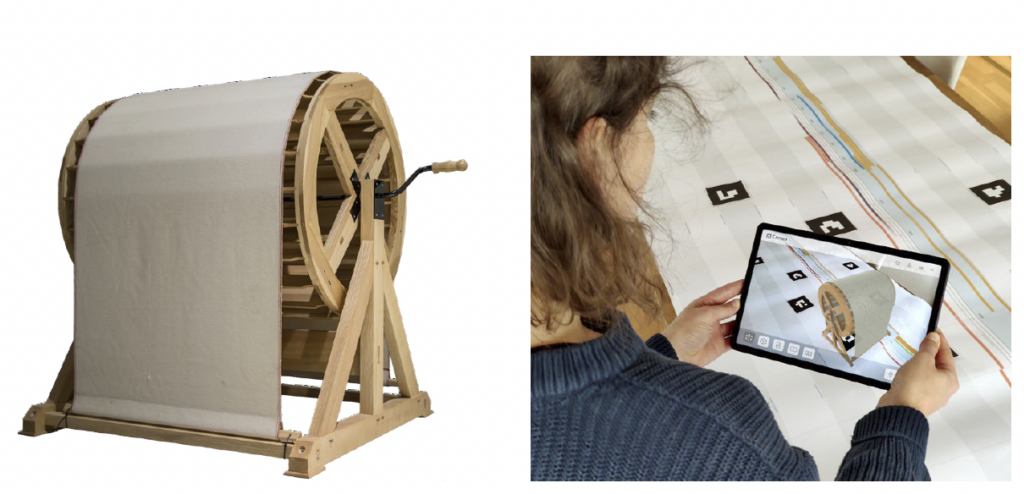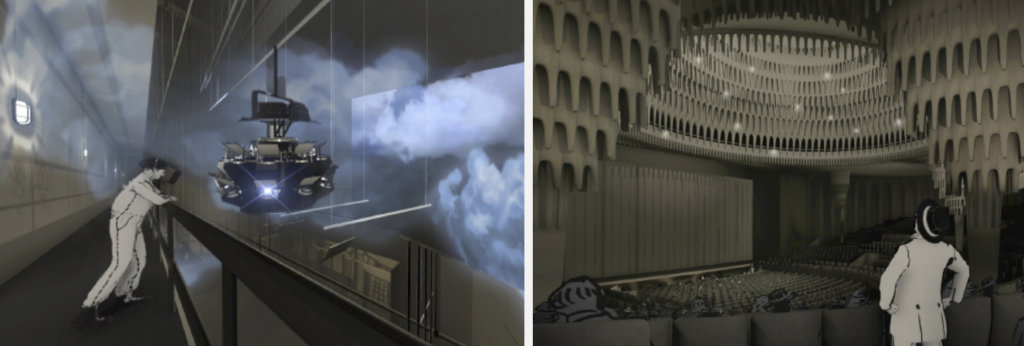Project: Virtual teaching and learning spaces
The project focuses on the development of digital, interactive training modules within a project unit. Innovative teaching and learning tools have been created for virtual reality. Virtual Reality can significantly contribute to practical learning and the acquisition of experiential knowledge, especially in spatial learning, technical preparation, and avoiding injury risks in a simulated work environment.
The use of a virtual learning space provides the opportunity to make hidden structures visible and facilitates the learning of extensive technical skills in a straightforward manner. Often, the size of learning groups and the temporal constraints tied to a specific location hinder individual experimentation and learning. The listed projects, including the 3D reconstruction of a chain hoist as a construction project for rehearsal stages and the skills training in microphone techniques through the „Sound Space“ contribution, address various aspects.
- „Virtual Chain Hoist Exercise“: A VR prototype designed for a theater lab, this exercise involves selecting the right chain hoist, understanding components, and solving context-specific challenges set by a lecturer.
- „Safety Signs“: Users memorize safety sign functions and engage in a fire-fighting exercise, choosing the correct fire extinguisher and maintaining the proper safety distance in this virtual learning space.
- „Rehearsal Stage Setup“: This virtual space reduces rehearsal stage construction time by shifting planning to the virtual realm, addressing challenges in transforming stage designs into plans using standard materials.
- „Sound Space – Microphonation“: Users explore instrument microphone setups in a virtual learning environment, comparing sound qualities in a stage and recording studio, understanding pick-up positions, and microphone types.
- „Hazard Detector“: A virtual learning space in a trade fair hall, users test theoretical knowledge with a suspended rig, conducting safety checks and identifying hazards, simulating challenges faced by event technicians.
- „Bending Beam“: Using theater objects, this virtual learning space teaches technical mechanics, allowing users to understand the interplay of forces in a simulated trade fair hall, providing real-time feedback and serving as a tool for theoretical teaching.
- „Cybertheater 2077“: A learning game immersing users in various technical professions and theater departments, modeled after a pre-university internship, engaging prospective and advanced students, alumni, and professionals in the virtual theater world.
- „Let There Be Light“: This VR project teaches lighting technology through exercises in stage lighting, object tracking, and additive color mixing. Divided into theory and practice rooms, it targets students, trainees, and the general public, with flexible upgrades based on specific learning groups or audiences.
For virtual learning to function seamlessly, strong engagement from all participants and flexible adaptation to constantly changing conditions are crucial.

Project: Digital twins of theatre technology history
„CANON“ brings together educators and students from nine European universities to create an open database and teaching approaches focused on preserving the cultural heritage of international theatre technology. The foundation of the project encounters a challenge in teaching the history of theatre technology, particularly due to the complexity of the machineries.
The project’s prototype is crafted for a teaching setting featuring a timeline on a table or wall, allowing the placement of content linked to a media database. This database’s 3D objects can be dynamically visualized in augmented reality, incorporating photos, videos, texts, or diagrams.
The key advantage lies in the ability to visually demonstrate machine functions, utilizing a dynamic 3D representation with sound, video, images, and supporting texts for easy access to theatre history. Integrated into lessons through QR codes and the CANON database, this tool supports diverse teaching scenarios (frontal, teamwork, free work, presentation) with different methods and didactics, including a „guided tour,“ the „explorer“ discovery mode, or the „flaneur style.“

Project: Bringing theatre heritage to life
„Virtual Reality Time Travel Berlin 1927“ is an immersive project that takes you on a journey to explore the history of the theatre. By integrating historical artifacts from Stadtmuseum Berlin and other archives, the project addresses the challenge of making cultural heritage accessible. It also examines how digital tools in archives and virtual reality can bring historical theatre architecture to life. The project, marking the 100th anniversary of the Große Schauspielhaus, offers both an exhibition installation and a freely accessible VR application, providing a unique and spatial experience of the theatre’s history, architecture, and art. The participants are accompanied by one of three virtual characters, each offering a different perspective of the theatre and providing a dynamic exploration the heritage.

Ressources
DTHG: Abschluss-Publikation des Forschungsprojektes „Im/material Theatre Spaces“